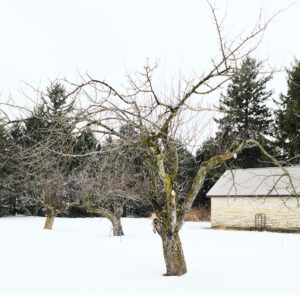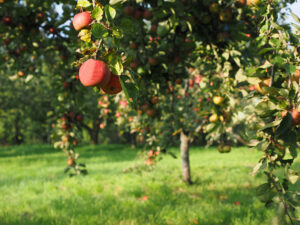Door County Almanak, No. 2, 1985
Door County folks are a varied lot, but one common trait is an appreciation for the outdoors – an affinity for green, growing things. My enthusiasm often leads me to a feeling of wild infatuation with whatever plant is currently in bloom, from hepatica and bloodroot on through lilacs, forget-me-nots, lady’s slippers, roses, and asters. The warm seasons become one long “high” as I revel in the annual parade.
But inevitably the procession ends, green turns to brown and disappears under white. House plants are tame compensation. Frustrated, I turn again to the outdoors. Fortunately, here in Door County, we are surrounded by a great number of trees to keep us company during the winter. Undistracted by gaudy flowers, I then can appreciate anew the lacy patterns of bare branches and even learn to identify the varieties by silhouette alone.
Evergreens comfort me with their assurance of continuing life, but as a child of the temperate zone, I do relish change. If I were to choose the perfect plant – one that is outstanding in all seasons – I would quickly narrow the field down to fruit trees.
Not the tallest or the sturdiest or easiest to grow, but certainly among the most beautiful in spring and most valuable at the time of harvest, fruit trees are desirable as the focal point of home landscaping and as a cash crop for orchardists. Fruitwood is in demand for many forms of woodworking, and even the imperfect parts as useful as firewood.
 Seen in wintertime, a fruit tree is likely to be symmetrical and bushy. In an orchard, the smaller branches will be pruned, and the larger ones may be forcibly spaces apart for higher fruit yield. This can produce a gnarled appearance which, when softened by snow cover, is most distinctive.
Seen in wintertime, a fruit tree is likely to be symmetrical and bushy. In an orchard, the smaller branches will be pruned, and the larger ones may be forcibly spaces apart for higher fruit yield. This can produce a gnarled appearance which, when softened by snow cover, is most distinctive.
Spring’s advance is charted in Door County by the development of cherry and apple buds. Fruit trees in full bloom provide such spectacular beauty that they have become a tourist attraction. Seen from a distance, an orchard in full bloom may appear to be covered with magical gauze. The closer you get, the more you will be caught up in the brightness, delicacy, and fragrance of the individual flowers and the music of the honeybees. Surely this is the apex of spring!
As summer passes, developing fruit changes the trees with its color and weight. Cherry tree branches sag nearly to the ground by July as the fruit ripens from green through orange to bright red. Finally, the trees seem relieved to shake free of their burden. Apple trees carry their fruit much longer, often into October, and may come to look like Christmas trees decorated with large red or yellow ornaments.
Cherries, plums, and pears are all delicious fruits, but my personal favorite is the apple. Its many attractive varieties and endless uses sometimes overshadow how good it is for us.
 An apple tree is also most likely to age well. It can be very sad to watch the decline of a cherry orchard which has given so much pleasure to all the senses. Once the peak years of production have passed, the trees quickly fall prey to storm damage and disease. Apple trees have a much longer life cycle and only get more gnarled and dignified with age. Scattered around the county are quite a few solitary apple trees, apparently untended yet faithfully continuing to bloom and produce fruit long after their planters have moved on.
An apple tree is also most likely to age well. It can be very sad to watch the decline of a cherry orchard which has given so much pleasure to all the senses. Once the peak years of production have passed, the trees quickly fall prey to storm damage and disease. Apple trees have a much longer life cycle and only get more gnarled and dignified with age. Scattered around the county are quite a few solitary apple trees, apparently untended yet faithfully continuing to bloom and produce fruit long after their planters have moved on.
On the basis of beauty, usefulness, and durability, my choice for the most perfect plant in Door County is the apple tree.


